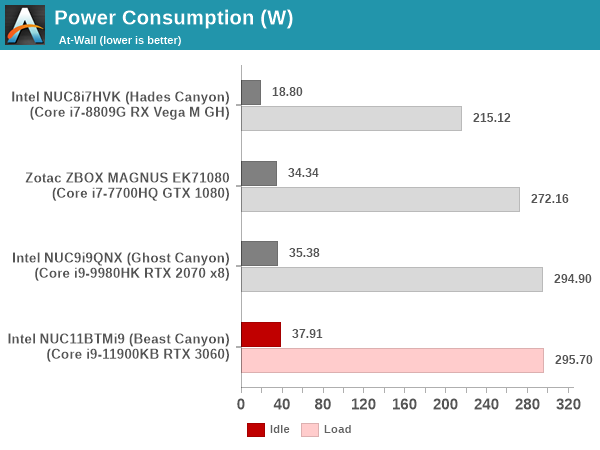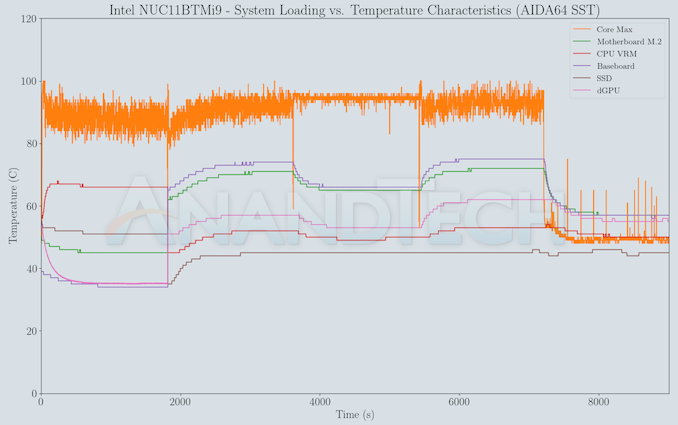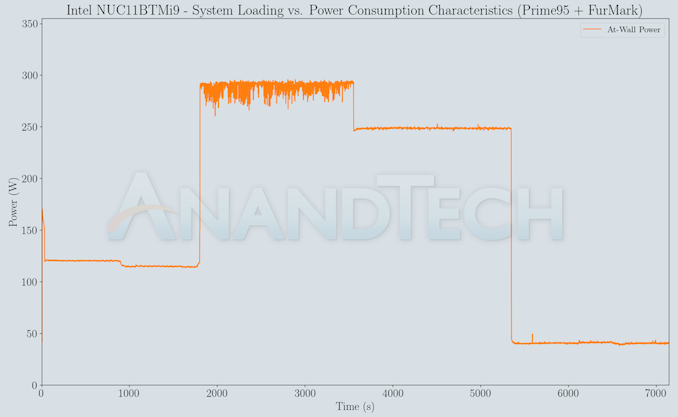Intel Beast Canyon NUC Review: Desktop Tiger Lake Debuts in SFF Gaming Powerhouse
by Ganesh T S on July 29, 2021 9:00 AM EST- Posted in
- Systems
- Intel
- NUC
- Tiger Lake
- NUC11
- Beast Canyon
Power Consumption and Thermal Performance
The power consumption at the wall was measured with a 4K display being driven through the HDMI port of the discrete GPU. In the graphs below, we compare the idle and load power of the Intel NUC11BTMi9 (Beast Canyon) with other similar PCs evaluated before. For load power consumption, we ran the AIDA64 System Stability Test with various stress components, as well as the artificial power virus test involving Prime95 and Furmark. The maximum sustained power consumption at the wall was recorded.

The numbers are very similar to the ones obtained for the Ghost Canyon NUC.
Our thermal stress routine starts with the system at idle, followed by four stages of different system loading profiles using the AIDA64 System Stability Test (each of 30 minutes duration). In the first stage, we stress the CPU, caches and RAM. In the second stage, we add the GPU to the above list. In the third stage, we stress the GPU standalone. In the final stage, we stress all the system components (including the disks). Beyond this, we leave the unit idle in order to determine how quickly the various temperatures in the system can come back to normal idling range. The various temperatures and power consumption number for the system during the above routine are presented in the graphs below.
While the CPU package manages to stay below the junction temperature during the system stability test, it does hover very close to the limits. This is likely due to the fans not taking effect soon enough, as the BIOS tries to maintain a balance between noise levels and cooling efficiency. It is likely that the production BIOS will need to sacrifice some noise levels for better thermals. Despite significant loading on the SSD, the thermal solution is good enough to keep the temperature below 75C.
A similar test routine is conducted with Prime95 running in maximum power consumption mode for 30 minutes, followed by the addition of a FurMark stress workload for another 30 minutes. After a cumulative run time of a hour, the Prime95 workload is removed, and FurMark allowed to proceed for another 30 minutes. The system is then left idle for another half an hour. The metrics tracked in the AIDA64 SST case are also tracked here.
The artificial power virus test significantly amps up the power consumption when both Prime95 and Furmark are simultaneously active. The GPU temperature is also a bit toasty and seems to suffer some after-effects of the Furmark loading. However, the core temperature quickly falls down to around 50C, thanks to the well-ventilated chassis and the three fans on the top panel.














84 Comments
View All Comments
Spunjji - Friday, July 30, 2021 - link
The original "Next Unit of Computing" was specifically meant to be an extremely small (below ITX sized) system that was significantly smaller than could be assembled by an end-user from off-the-shelf parts - not just an "SFF desktop".Kaby G was a stretch, but it was still as small as you could get for the power. As notashill noted this one is way, way past that goal. They're free to dilute their branding if they want to, but that's absolutely what they're doing here.
Tams80 - Sunday, August 8, 2021 - link
Eh. Is it really offering anything unique that is hard (too hard) for an average person to bodge together on their own from off the shelf parts?No, it isn't. The other NUCs so far have been something you couldn't just buy the components for and assemble with no skill in perhaps an hour.
mode_13h - Monday, August 9, 2021 - link
> Is it really offering anything unique that is hard (too hard) for> an average person to bodge together on their own from off the shelf parts?
Please show me where I can find a Tiger Lake-H CPU and motherboard, off-the-shelf. You can't because it's BGA-only.
> The other NUCs so far have been something you couldn't just buy the components
> for and assemble with no skill in perhaps an hour.
Because (like this!) they use laptop parts in a (compact) desktop enclosure.
In this case, the only real exception is the GPU. And the fact that it's on a regular graphics card is a feature, since that makes it upgradable.
defaultluser - Thursday, July 29, 2021 - link
Yeah, they even phoned-in the case design - it's exactly the same look as a Cougar QBX.https://www.newegg.com/p/N82E16811553020?quicklink...
powerarmour - Thursday, July 29, 2021 - link
Exactly, I'm struggling to see any genuine innovation here, at least it was fun seeing what they could cram into 1.2L, now they might as well rebrand Alienware boxes and call it a day.Apple will have M2 ready soon, and here we have another generic 5L bread bin with a 650W PSU.
Spunjji - Friday, July 30, 2021 - link
Oh neat - a new case to look at next time I do an SFF build. Thanks!beginner99 - Thursday, July 29, 2021 - link
Fully agree. You can get smaller sff pc cases than this and put similar components in it. The NUC has been about not being able to build such a small thing yourself because it was essentially custom.damianrobertjones - Friday, July 30, 2021 - link
'Next Unit of Computing'.Nowhere does it state that they have to be small.
powerarmour - Friday, July 30, 2021 - link
And toilets don't have to be bowl shaped either... there's a clear inference (after eight generations at least) that these things should be small and compact.Wrs - Saturday, July 31, 2021 - link
It does remove a lot of the purpose for buying it when any old SFF case can house the same components without locking you to Intel cards